Storms | Power Outage | Extreme Heat | Winter
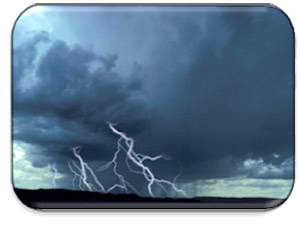 Prepare and Respond to a Thunderstorm
Prepare and Respond to a Thunderstorm
Remember: If you can hear thunder, you are close enough to the storm to be struck by lightning.
— When Thunder Roars, Go Indoors! —
Before a Storm
- Go to safe shelter immediately
- Check the weather forecast before leaving for extended periods outdoors.
- Watch for signs of approaching storms. If a storm is approaching, keep a NOAA Weather Radio or AM/FM radio with you.
- Postpone outdoor activities if storms are imminent.
- Check on neighbors who require special assistance such as infants, the elderly, and people with disabilities.
During a Thunderstorm
- Go to a safe shelter immediately or move to a more sturdy building.
- Do not take shelter in small sheds, under isolated trees, or in convertible automobiles.
- If lightning occurs and sturdy shelter is not available, get inside a hard top automobile and keep windows up.
- Get out of boats and away from water.
- Telephone lines and metal pipes can conduct electricity. Unplug appliances not necessary for obtaining weather information.
- Avoid using the telephone or any electrical appliances. Use phones only in an emergency.
- Do not take a bath or shower.
- Turn off air conditioners. Power surges from lightning can overload the compressors.
- Get to higher ground if flash flooding or flooding is possible. Do not attempt to drive to safety. Most flash flooding deaths occur in automobiles.
If you cannot go indoors
- Find a low spot away from trees, fences, and poles. If you are in the woods, take shelter under short trees.
- If you feel your skin tingle or your hair stands on end, perform the following actions:
• Squat low to the ground on the balls of your feet.
• Place your hands on your knees with your head between them.
• Make yourself the smallest target possible
• Minimize your contact with the ground.
After the Storm
- Check on neighbors who may require special assistance -infants, the elderly, and people with disabilities.
- Avoid all downed power lines. Assume that all have live electricity.
Continue to monitor NOAA Weather Radio and your local media for latest weather updates and official information.
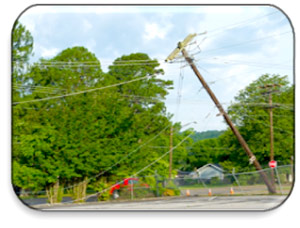 Prepare and Respond to a Power Outage
Prepare and Respond to a Power Outage
Be Prepared!
- At home or at work, keep a battery-operated radio and flashlight on hand, as well as a supply of batteries.
- Keep an emergency supply of water, medications, and non- perishable foods handy. If you use medication that requires refrigeration, most can be kept in a closed refrigerator for several hours without a problem-check with your physician or pharmacist.
- If you have space in your refrigerator or freezer, consider filling plastic containers with water, leaving an inch of space inside each one -this will help keep food cold if the power goes out.
- Have a list of emergency numbers readily available. Keep your vehicle gas tank at least half-full.
- Plan to have an alternative-cooking source, such as a camp stove or outdoor grill.
- Follow appropriate safety rules for its use outside the residence.
- Consider buying a generator and follow the rules for using it outside the residence.
- Before installing a generator, be sure to properly disconnect from your utility electrical service. If possible, have your generator installed by a qualified electrician.
- Have extra blankets, coats, hats, and gloves on hand to keep warm.
- If you have a computer, back up files and operating systems regularly. Turn off all computers, monitors, and other devices when they are not being used.
- If you have an electric garage door opener, locate the manual release level and learn how to operate.
- If you have a telephone instrument or system that requires electricity to work, plan for alternate communication such as a standard telephone handset, cellular telephone, or radio.
During an Outage
- Listen to local broadcasts for official information.
- Turn off major appliances to prevent damage from a possible surge when the power comes back on - keep one light turned on, so you know when power returns.
- Call your utility provider to notify them of the outage.
- Check to see if your neighbors have power.
- Check on people with special needs.
- Use only flashlights for emergency lighting – candles pose the risk of fire
- Keep your refrigerator and freezer doors shut to keep food from spoiling.
- When in doubt, throw it out!
- Do not use a charcoal grill indoors and do not use a gas stove for heat - they could give off harmful levels of carbon monoxide.
- In cold weather, stay warm by dressing in layers and minimizing time spent outdoors. Be aware of cold stress symptoms (i.e., hypothermia) and seek proper medical attention if symptoms appear.
- In hot weather, take steps to remain cool. Move to the lowest level of the house. Wear lightweight, light-colored clothing. Drink plenty of water.
- If you are in a tall building, take the stairs and move to the lowest level of the building.
- If trapped in an elevator, wait for assistance. Do not attempt to force the doors open. Remain patient -there is plenty of air and the interior of the elevator is designed for passenger safety.
- Remember to provide fresh, cool water for your pets.
- Eliminate unnecessary travel, especially by car.
- Traffic signals will stop working during an outage, creating traffic congestion and dangerous driving conditions. It you must drive during a blackout, remember to obey the 4-Way Stop rule at intersections with non-functioning traffic signals.
- Remember that equipment such as automated teller machines (ATMS) and elevators may not be working.
- Call your local emergency response number for help, if needed.
People with Special Needs
- If someone you know is elderly or dependent on life-sustaining or health-related equipment (i.e., ventilators, respirators, oxygen concentrators, or enhancers), help plan to make sure their needs are met by taking the following actions:
• Register them as a special needs customer with their utility so they will become a priority customer.
• Notify others that could provide help such as fire department, neighbors, nearby friends, or relatives.
• Have a list of emergency numbers readily available.
• Have a standby generator or an alternative source of power available. Be aware of the safety rules for its use.
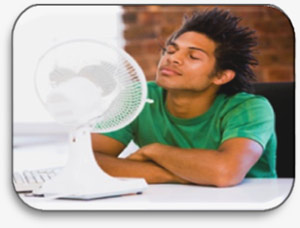 Prepare and Respond to Extreme Heat
Prepare and Respond to Extreme Heat
Heat Safety Tips
*Things to Remember during a Heat Wave (90 degrees F or higher for 48 hours.)
- Limit strenuous activity during the sun's peak hours, 11:00 a.m. to 4:00 p.m. Outside exercise should be during the early morning between 4:00 & 7:00 a.m.
- Eat less protein and more fruits and vegetables. Protein produces and increases metabolic heat, which causes water loss.
- Eat small meals, but eat more often. Limit salty foods.
- Drink at least 2-4 glasses of water per hour during extreme heat even if you do not feel thirsty.
- Avoid beverages containing alcohol or caffeine.
- If possible, stay out of the sun and stay in air conditioning.
- Sunburn slows the skin's ability to cool. The sun will also heat the inner core of your body, resulting in dehydration. If air conditioning is not available, stay on the lowest floor, out of the sunshine, or go to a public building with air conditioning.
- If you must go outdoors, wear sunscreen with a high sun protector factor rating (at least SPF 15) and a hat to protect your face and head.
- When outdoors, wear loose-fitting lightweight and light-colored clothing.
- Cover as much skin as possible to avoid sunburn and over-warming effects of sunlight on your body.
- Do not leave children, pets or those who require special care in a parked car or vehicle during periods of intense summer heat
- Temperatures inside a closed vehicle can reach over 140 degrees Fahrenheit quickly. Exposure to such high temperatures can kill within a matter of minutes.
- Make an effort to check on your neighbors during a heat wave, especially if they are elderly, have young children or have special needs.
- Make sure there is enough food and water for pets.
People at Higher Risk
- Elderly
- Small Children
- People with weight or alcohol problems are very susceptible to heat reactions.
- People on certain medications.
Heat Cramps
- Heat cramps are muscular pains and spasms caused by heavy exertion. Loss of water and salt from sweating causes cramping.
- Signals of heat cramps are abdominal and leg muscle pain.
- Relief can be firm pressure on cramping muscles, or gentle massages to relieve cramping.
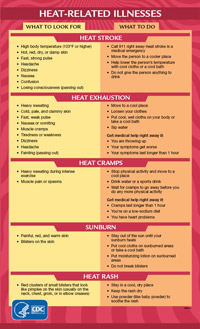 Heat Exhaustion
Heat Exhaustion
- This condition is less dangerous than heat stroke. It usually occurs when people exercise too heavily or work in warm, humid places where body fluids are lost.
- Signals include cool, moist, pale or flushed skin; heavy sweating; headache, nausea or vomiting, dizziness and exhaustion.
- If symptoms occur, get the victim out of sun, and apply cool, wet cloths.
Heat Stroke
- Also known as sunstroke-can be life threatening. Body temperature can rise and cause brain damage; death may result if not cooled quickly.
- Symptoms include hot, red, and dry skin; changes in consciousness; rapid, weak pulse, and shallow breathing.
- Relief for lowing body temperature can be with a cold bath or sponge.
Sunburn
- Symptoms include redness and pain; in severe cases, swelling of skin, blisters, fever and headaches can occur. Sunburn hampers heat dissipation.
- Ointments can be a relief for pain in mild cases.
- A physician should see serious cases.
For more about how to “Beat the Heat”, visit our Tips for Summer Heat page
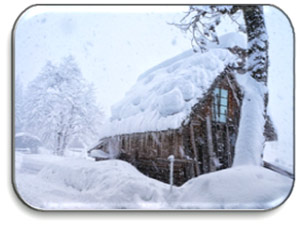 Prepare and Respond to Extreme Winter Weather
Prepare and Respond to Extreme Winter Weather
Prepare your Home for Winter Indoor Fire Safety Tips Winter Road Safety Tips Winter Outdoor Safety Pet Protection Tips
National Weather Service Warnings.
- Winter Storm Warning
Issued for a combination of heavy snow and/or ice, of which, at least one exceeds or meets warning criteria. Winter weather is expected to cause life-threatening public impact for a combination of winter hazards including heavy snow, ice, near blizzard conditions, blowing and drifting snow and/or dangerous wind chills. - Ice Storm Warning
Issued for a ½ inch or more of ice accumulation that causes damage to power lines and trees. Ice Storm Warnings are issued when there is a high degree of confidence that the entire event is expected to be ice. - Blizzard Warning
Issued when blizzard conditions are imminent or expected in the next 12 to 24 hours. Blizzard conditions include sustained or frequent gusts of or above 35 mph AND considerable falling, blowing and drifting of snow reducing visibilities frequently 1/4 mile. - Lake-Effect Snow Warning
Issued for 7 inches or more of lake-effect snow. - Wind Chill Warning
Issued when the wind chill is expected to be -25F or less. Frostbite can occur in less than 10 minutes.

